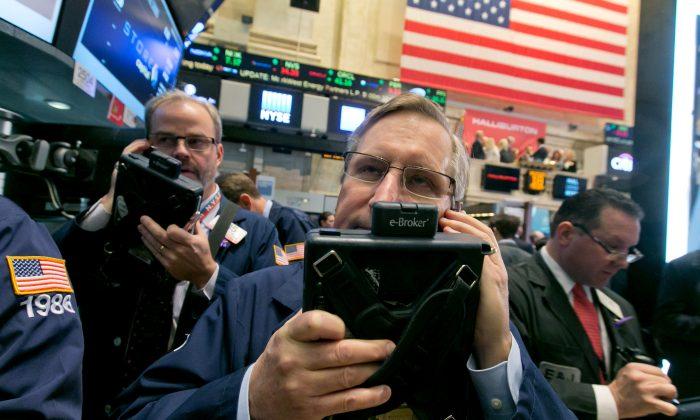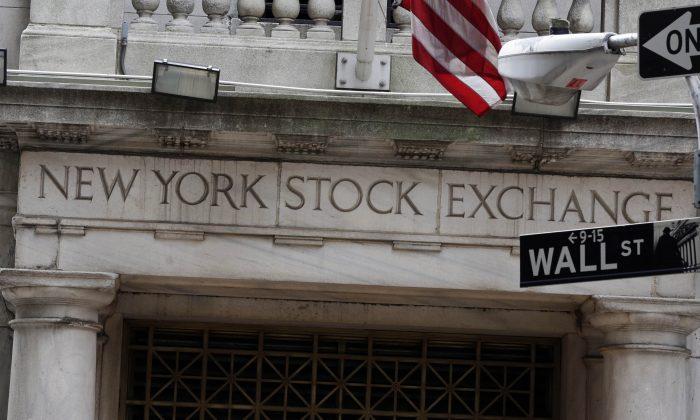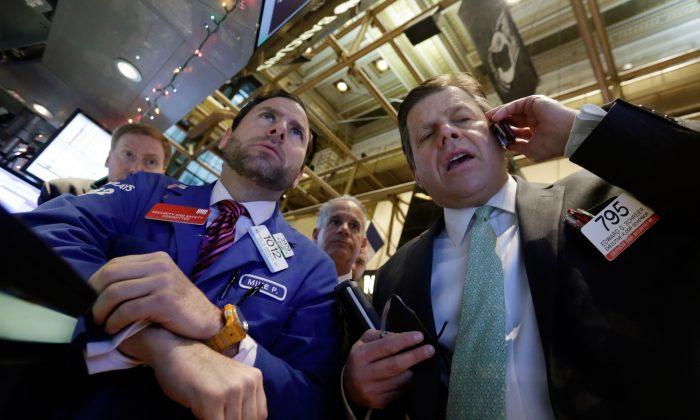NEW YORK—The U.S. stock market had its best day in more than a year after the Federal Reserve said it would to remain “patient” in its approach to raising interest rates.
Stocks rose from the open on Wednesday, led by energy companies, as oil prices showed signs of stabilizing from a big slump. The market’s gains were extended after Fed policymakers released a statement following the end of a two-day meeting.
A near six-year bull run for the U.S. stock market has been helped by the Fed’s huge stimulus, which has pushed down borrowing costs At the start of the month investors worried that signs of a strengthening economy would lead policymakers to bring forward the start of rate increases. But on Wednesday, the central bank said it foresaw no rate hike in the first three months of 2015.
“The Fed is going to be our friend for a very long time,” said Burt White, chief investment officer for LPL Financial. “Growth continues to be good and corporate America is healthy. If you mix all that together it translates to rising stock prices.”
The Standard & Poor’s 500 index rose 40.15 points, or 2.04 percent, to 2,012.89. That was the biggest gain for the index since October 2013.
The Dow Jones industrial average gained 288 points, or 1.7 percent, to 17,356.87. The Nasdaq composite climbed 96.48 points, or 2.1 percent, to 4,644.31.
Stock investors have had a wild ride in the final quarter of the year. The market plunged at the start of October on concerns that global growth was slowing. Then it rebounded and surged to record levels at the start of December, before falling sharply last week as the price of oil collapsed, dragging down energy stocks.
Despite the heightened volatility, long-term investors should stick to their long-term goals, rather than jump in and out of stocks and sectors, said Jeff Lancaster, a principal of San Francisco-based Bingham, Osborn & Scarborough.
“I don’t see anything that looks so tempting, or so perilous, that you should lurch to the left or the right,” Lancaster said.
On Wednesday, energy stocks led gains for the S&P 500 index as the price of oil steadied. Stocks in the sector jumped 4.2 percent, cutting their losses for the year to 13 percent. The sector was down as much as 17 percent in the year-to-date as of Monday.
The price of U.S. oil rose Wednesday after the U.S. Energy Department reported a decline in inventories, a reversal of an earlier report of increased inventories from an industry group.
Benchmark U.S. crude rose 54 cents to close at $56.47 a barrel. Brent crude for February delivery, a benchmark for international oils used by many U.S. refineries, rose $1.17 to close at $61.18 a barrel. The January Brent contract expired Tuesday at $59.86.
Stocks that were linked to Cuba surged after President Barack Obama announced the re-establishment of diplomatic relations with the country on Wednesday. He declared an end to America’s “outdated approach” to the communist island in a historic shift aimed at ending a half-century of Cold War enmity.
Copa Airlines, a Panama City-based carrier, and one of the most successful airlines in Latin America, jumped. Its stock rose $6.36, or 7.2 percent, to $94.48 on the news.
The Herzfeld Caribbean Basin Fund, a closed-end fund designed to take advantage of greater trade with Cuba, surged $1.97, or 28.9 percent, to $8.78.
In corporate news, FedEx was one of the biggest losers in early trading after in the shipping company reported earnings that fell short of Wall Street’s expectations. The company said a jump in plane maintenance costs blunted gains the company reaped from managing costs, lowering its pension expense and growing its export package revenue. The company’s stock dropped $6.48, or 3.7 percent, to $167.78.
Russia also remained in focus on concerns about the impact of the recent slide in the ruble. The currency has lost more than 50 percent of its value this year. After falling again early Wednesday, the ruble recovered and was 10 percent higher at 62.37 rubles to the dollar.
Russian authorities Wednesday indicated that they would sell foreign currency to relieve pressure on the ruble. The Russian currency has suffered in the wake of sliding oil prices and sanctions imposed over Russia’s involvement in Ukraine’s crisis.
In U.S. government bond trading, prices fell. The yield on the 10-year benchmark Treasury note, which rises when prices fall, climbed to 2.14 percent from 2.08 percent a day earlier.
The price of gold was little changed from Tuesday at $1,194.50 an ounce. Silver rose 18 cents to $15.93 an ounce and copper rose a penny to $2.87 a pound.
In other energy futures trading on the NYMEX:
- Wholesale gasoline rose 2.5 cents to close at $1.566 a gallon.
- Heating oil rose 4.9 cents to close at $2.009 a gallon.
- Natural gas rose 8.3 cents to close at $3.702 per 1,000 cubic feet.
From The Associated Press





Friends Read Free